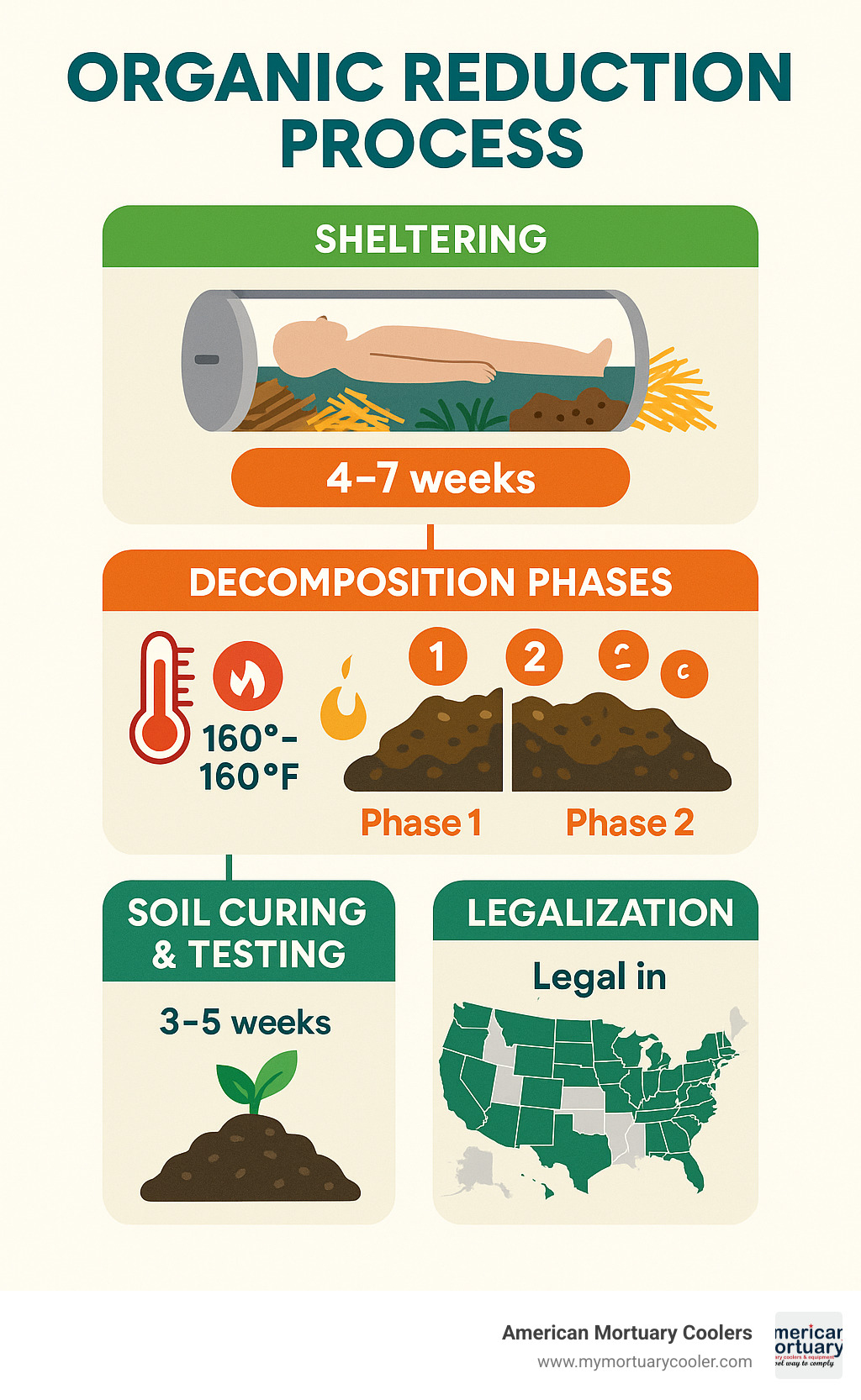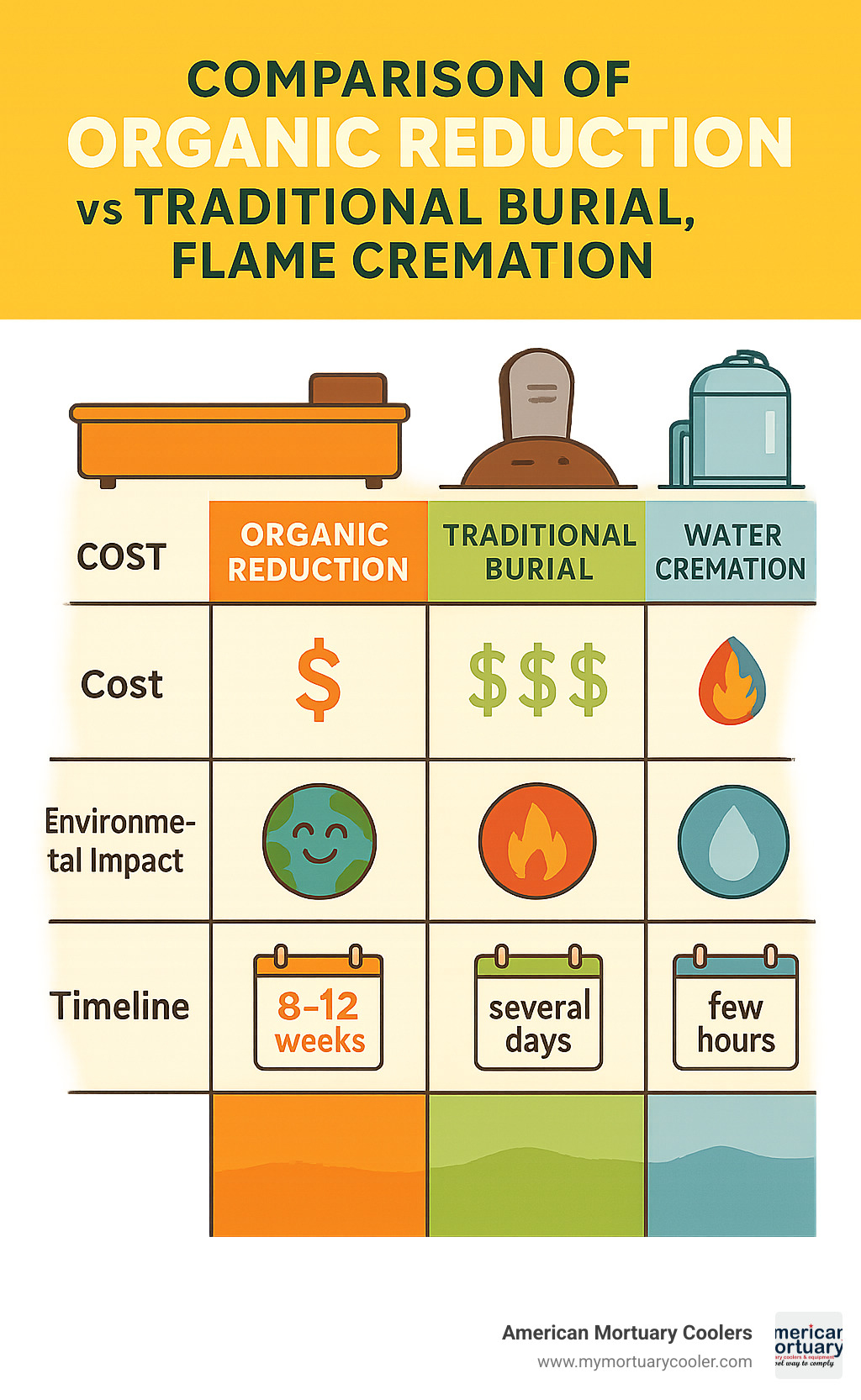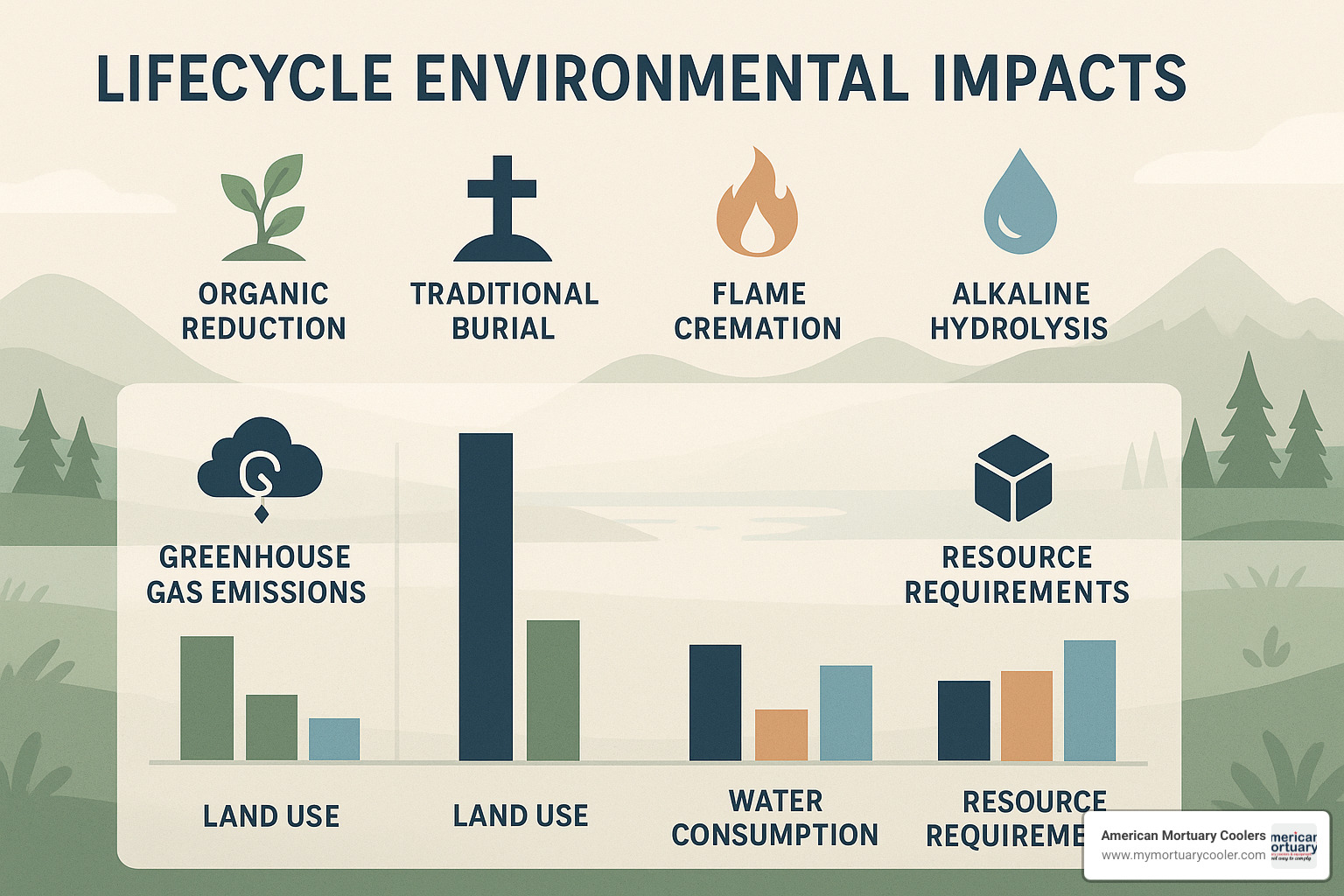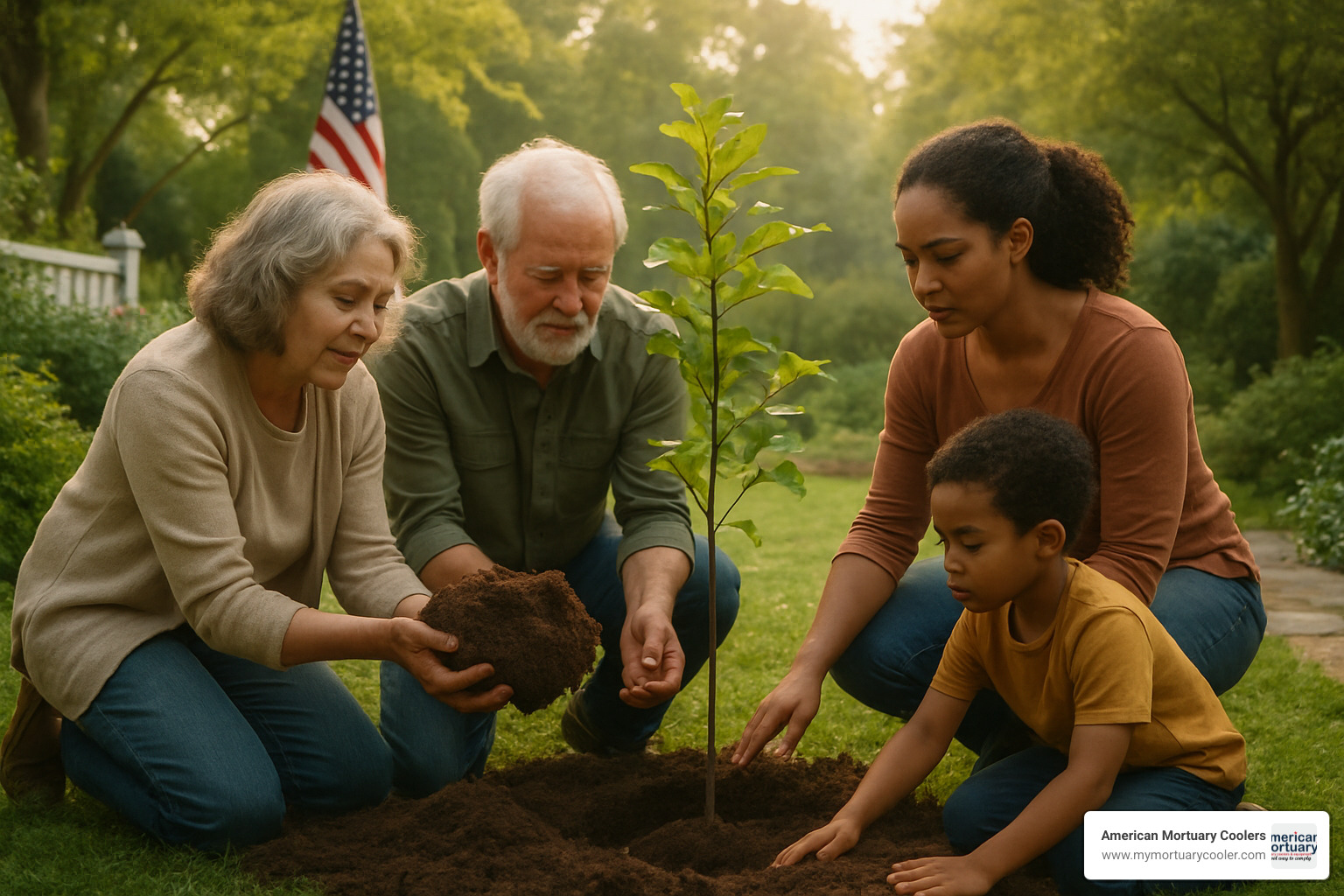What Is Organic Reduction and Why It Matters
Organic reduction is a natural process that transforms human remains into nutrient-rich soil over approximately 4-7 weeks using controlled decomposition. Also known as natural organic reduction (NOR) or human composting, this eco-friendly alternative to traditional burial and cremation is gaining popularity across the United States.
Key Facts About Organic Reduction:
- Process Time: 4-7 weeks for decomposition + 3-5 weeks for soil curing
- Output: About 1 cubic yard (up to 200 pounds) of fertile soil per body
- Legal Status: Currently legal in 11 U.S. states as of 2024
- Cost: Starting around $6,499, less expensive than most traditional burials
- Environmental Impact: Significantly reduces carbon emissions compared to cremation and burial
The process uses a stainless-steel vessel filled with organic materials like wood chips, alfalfa, and straw. Microbes break down the remains at temperatures between 130-160°F, creating pathogen-free soil that families can use for memorial plantings or conservation projects.
Washington became the first state to legalize organic reduction in 2019, with the law taking effect in May 2020. Since then, ten additional states have followed suit, making this sustainable option available to millions of Americans seeking environmentally conscious end-of-life choices.
As Mortuary Cooler with years of experience providing specialized equipment to funeral homes nationwide, I've witnessed the growing demand for organic reduction services and the infrastructure needed to support them.

Organic reduction vocab explained:
Organic Reduction 101: Definition, History, Key Facts
What exactly is organic reduction? Simply put, it's the contained, accelerated conversion of human remains into soil. Scientists call it natural organic reduction (NOR), though you might also hear it called human composting or terramation. The end result is approximately one cubic yard of nutrient-rich soil that families can use to honor their loved one's memory.
The process builds on livestock composting techniques that farmers have used for decades. When the 2012 avian flu outbreak hit, agricultural authorities successfully composted millions of infected birds using similar methods. This real-world test proved that controlled organic composting could safely handle large-scale decomposition while preventing disease spread.
Washington state broke new ground in 2019 by becoming the first to legalize human composting. The law took effect in May 2020, opening doors that had been closed for generations. This was the result of years of work by pioneering companies like Recompose, Return Home, and Earth Funeral, who developed and refined the technology specifically for human application.
Scientific research on environmental benefits shows that organic reduction offers real ecological advantages. Each body processed through natural organic reduction can reduce carbon emissions by approximately one ton compared to conventional burial or cremation.
Early milestones in organic reduction
Sweden conducted some of the earliest trials in human composting, exploring sustainable alternatives when traditional methods seemed increasingly outdated. The 2012 avian influenza outbreak became an unexpected turning point when agricultural authorities needed to safely dispose of millions of infected birds quickly, and composting proved not only effective but remarkably safe at preventing disease transmission.
The legalization wave started slowly but picked up steam fast. After Washington's groundbreaking legislation, Colorado and Oregon jumped on board in 2021. Then came Vermont, California, and New York in 2022. The momentum continues with Arizona, Nevada, Delaware, Maryland, and Minnesota (effective July 2025) joining the movement.
The term "organic reduction" in funeral legislation
State lawmakers have been careful with their words when crafting these bills. Most statutory language refers to "natural organic reduction" or "soil change" rather than the more casual term "human composting." This careful word choice maintains dignity while accurately describing the scientific process.
The legislation typically requires operators to obtain licenses from state funeral regulators and follow strict protocols. This includes maintaining proper temperature controls, handling remains with care, and testing the final soil product before families receive it.
How Does the Organic Reduction Process Work?
The magic of organic reduction happens inside a carefully designed stainless-steel vessel that looks a bit like a large, horizontal cylinder. When a body arrives at the facility, it's placed inside this vessel along with a thoughtfully chosen blend of organic materials - wood chips for carbon, alfalfa for nitrogen, and straw for structure. This isn't a random mix; it's a precise recipe that creates the perfect environment for nature to do its work.

The vessel becomes a controlled ecosystem where temperature is everything. The mixture naturally heats up to 130°F to 160°F - hot enough to eliminate harmful bacteria like E. coli and Salmonella, but just right for the beneficial microbes that do the heavy lifting. These heat-loving bacteria and fungi, called thermophilic microbes, are the real heroes of the process.
Over the next 4-7 weeks, these tiny workers break down organic matter while the vessel contents are occasionally turned to keep oxygen flowing. After this active phase, the material enters a 3-5 week curing period where everything stabilizes and matures into rich, dark soil.
The final steps involve careful screening to remove any non-organic items like medical implants or jewelry, followed by laboratory testing to ensure the soil is completely safe.
Materials & micro-biology inside an organic reduction vessel
Creating the perfect environment for organic reduction is like following a recipe that nature has perfected over millions of years. The secret lies in achieving the right carbon-to-nitrogen ratio of 25-30:1. The carbon-rich wood chips and straw provide energy for the microbes, while the nitrogen from the body feeds them.
Inside the vessel, a complex community of thermophilic bacteria, fungi, and other microorganisms work together like a well-orchestrated team. These beneficial species thrive in high-heat environments and produce specialized enzymes to break down proteins, fats, and other organic compounds.
The vessel's ventilation system plays a crucial role by providing controlled airflow throughout the process. Regular aeration turns ensure oxygen reaches every corner of the mixture, maintaining the clean, aerobic environment that makes the whole process work efficiently and odor-free.
Timeline of an organic reduction cycle
The journey begins with a sheltering period of up to five days while paperwork is completed and final preparations are made. During this time, the body is kept in temperature-controlled conditions - similar to the mortuary coolers we provide to funeral homes across the country.
The active decomposition phase starts when the body joins the organic materials in the vessel. This is where the real change happens over 5-7 weeks. The temperature is carefully monitored and maintained while the vessel contents are turned periodically.
After active decomposition comes the curing phase, lasting another 3-5 weeks. This is when the soil matures and stabilizes, ensuring any remaining organic matter fully breaks down. The final step involves screening out non-organic materials and conducting thorough laboratory testing to verify the soil is pathogen-free before families receive their loved one's fertile earth.
Legality, Costs & Choosing a Provider
The legal landscape for organic reduction has expanded rapidly over the past few years. As of 2024, eleven U.S. states have accepted this sustainable option: Washington led the way in 2019, followed by Colorado, Oregon, Vermont, California, New York, Nevada, Arizona, Delaware, Maryland, and Minnesota (which becomes effective in July 2025). Several other states are actively considering similar legislation.

When it comes to cost, organic reduction offers a middle ground that many families find appealing. Services typically start around $6,499, which is significantly less than traditional burials that can run anywhere from $9,000 to $15,000. It's also competitive with full-service cremations, which average around $7,000.
If you live in a state where organic reduction isn't legal yet, don't worry - you still have options. Many providers offer interstate transport services, allowing them to bring your loved one to a facility in a state where the process is permitted. This does add some complexity and cost to the arrangements, but it makes the option accessible to families nationwide.

Choosing the right provider requires a bit of homework. Make sure any facility you're considering is properly licensed by their state's funeral regulatory board. Reputable providers will be upfront about their pricing, walk you through the timeline, and clearly explain what's included in their service packages. More information about specialized services can help you understand what goes into creating these facilities.
Where organic reduction is legal now
Washington state deserves credit for being the trailblazer. Their 2019 legislation took effect in May 2020, opening the door for this sustainable option. Colorado and Oregon joined the movement in 2021, recognizing both the environmental benefits and growing demand from their residents.
The year 2022 marked a major turning point when Vermont, California, and New York all passed legislation legalizing human composting. California's decision was particularly impactful given the state's large population and tendency to influence national trends.
The momentum has continued with Arizona, Nevada, Delaware, and Maryland all legalizing organic reduction in 2023 and 2024. Minnesota rounds out the current group with their law taking effect in July 2025, bringing the total to eleven states.
Organic reduction providers & facility needs
Three companies have emerged as the leaders in organic reduction services. Recompose, based in Washington, pioneered much of the technology we see today. Return Home has gained recognition for their excellent service, even winning the NFDA Best of the Best Award in 2022. Earth Funeral rounds out the top three.
Running an organic reduction facility requires serious infrastructure. The specialized stainless-steel vessels are just the beginning - facilities also need precise temperature and ventilation control systems, laboratory testing capabilities, and proper storage areas. At American Mortuary Coolers, we've worked with several facilities to provide the specialized cooling and storage equipment that supports these services.
Proper ventilation systems manage airflow and control odors, while temperature monitoring equipment ensures the process stays within the critical 130-160°F range. Facilities need dedicated space for both the active composting vessels and separate curing areas.
Environmental Benefits, Concerns & Comparisons
When it comes to caring for our planet, organic reduction truly shines as an eco-friendly choice. Each person who chooses this process saves about one ton of carbon emissions compared to traditional burial or cremation. That's like taking a car off the road for several months!
The environmental wins go far beyond just carbon savings. Think about all those embalming chemicals - over 800,000 gallons of toxic substances get used in the U.S. every year for traditional burials. These chemicals, including formaldehyde, don't just disappear after burial. They seep into groundwater and soil, creating contamination that lasts for decades.
Organic reduction completely eliminates this chemical burden. Instead of poisoning the earth, the process creates nutrient-rich soil that actually helps restore damaged land.
Land conservation is another huge benefit. Traditional cemeteries gobble up space and require constant maintenance - watering, mowing, and eventually expanding when they fill up. The fertile soil from organic reduction can support reforestation projects or help families create beautiful memorial gardens.
Of course, no process is perfect. Scientific research on pathogen safety has identified some key areas that need ongoing attention: disease control protocols, cost management, soil handling procedures, emergency response planning, and memorial preservation options.
How organic reduction stacks up against burial & cremation
Let's talk numbers. Cremation might seem clean, but each cremation pumps 400 to 1,000 pounds of CO2 into the atmosphere. That's from burning fossil fuels to reach those high temperatures. Plus, mercury from dental fillings gets released into the air we all breathe.
Traditional burial has its own environmental baggage. Beyond those toxic embalming chemicals, think about what goes into making caskets - steel mining, hardwood harvesting, and synthetic material production. Then there are concrete burial vaults, which require energy-intensive manufacturing.

Water usage tells another compelling story. Cremation facilities need massive amounts of water for cooling systems. Cemeteries require constant irrigation to keep those green lawns looking perfect. Organic reduction needs very little water by comparison.
Here's something amazing: the soil created through organic reduction keeps giving back to the environment. Adding just 1% more organic matter to soil helps it hold an extra 20,000 gallons of water per acre. That supports local plants and wildlife while preventing erosion.
Criticisms & ethical questions
Not everyone accepts organic reduction, and that's understandable. The U.S. Catholic Church has raised concerns, arguing that accelerated composting doesn't show proper respect for human remains. Some religious leaders feel it treats the body more like organic waste than recognizing its sacred nature.
Jewish communities have had thoughtful debates about whether organic reduction meets traditional burial requirements. Some rabbinical authorities have concerns, while others see it as a beautiful way of returning the body to the earth.
The memorialization question weighs heavily on many families. Without a traditional grave or urn of ashes, how do you create a meaningful place to remember and visit your loved one?
There are practical concerns too. What happens during mass casualty events or disease outbreaks? The current timeline of several months per person could create challenges when public health emergencies require faster processing of remains.
After the Process: Receiving & Using the Soil
When the organic reduction process is complete, families receive approximately 200 pounds of nutrient-rich soil - about one cubic yard of earth that has been thoroughly tested and certified safe for use. This isn't ordinary dirt; it's fertile, pathogen-free soil that can support plant growth for decades to come.
The change is remarkable when you think about it. What began as a person's physical remains has become something that can nurture new life, whether that's a memorial tree in the backyard or wildflowers in a conservation area. Many families find deep meaning in this continuation of the life cycle.
Memorial tree planting has become one of the most popular choices for families. The tree becomes a living memorial that changes with the seasons, providing shade, beauty, and habitat for wildlife.
Others choose to donate portions of their soil to conservation projects. Reforestation efforts, erosion control initiatives, and community gardens all benefit from the nutrient-rich composition. This option appeals to families whose loved ones were passionate about environmental causes during their lifetime.
The soil can be stored in breathable containers rather than sealed urns, allowing the organic material to continue its natural processes. Some families keep a small amount in special memorial containers while using the majority for planting projects.
More information about specialized services can help families understand their options for using and memorializing the soil from organic reduction.

Transporting organic reduction soil safely
Before families receive their soil, it undergoes rigorous laboratory testing to ensure complete safety. Every batch is checked for harmful bacteria like E. coli and Salmonella, plus screened for heavy metals that could pose risks to plants or soil health.
Shipping the soil is surprisingly straightforward within the United States. Since the final product is classified as treated organic material rather than human remains, it can be transported using standard freight services. Most providers offer direct shipping to families, though some provide personal delivery for clients within their local area.
The regulations become more complex for international transport. Different countries have varying customs requirements, and some may need additional documentation or testing certificates.
Creative memorial projects with organic reduction soil
The possibilities for meaningful memorial projects extend far beyond traditional options. Some families create dedicated memorial gardens on their property, designing spaces where friends and relatives can visit, reflect, and enjoy the beauty of plants nourished by their loved one's soil.
Conservation partnerships have emerged as a popular choice for environmentally conscious families. Organizations focused on reforestation gladly accept soil donations for restoration projects. Knowing that their loved one continues contributing to environmental healing brings comfort to many families.
Community gardens represent another heartwarming option. The soil can help grow fresh produce for local food banks or community members, creating ongoing positive impact that extends well beyond the family.
Some families have found that the soil works exceptionally well for erosion control projects. The nutrient-rich composition helps establish new plant growth in challenging environments, creating lasting environmental benefits while honoring the memory of someone who cared about the natural world.
Frequently Asked Questions about Organic Reduction
When families first learn about organic reduction, they naturally have questions about how the process works and what to expect. Having worked with funeral homes across the country as they've added this service, I've heard these same questions countless times. Let me share the answers to the most common ones.
How long does organic reduction take from start to finish?
The complete organic reduction journey takes about three months from beginning to end. Your loved one will spend 4-7 weeks in the active decomposition phase inside the specialized vessel, where the actual change happens. After that comes the curing period of 3-5 weeks, which allows the soil to stabilize and mature properly.
The timeline doesn't end there, though. Laboratory testing adds another week or two to ensure the soil is completely safe and pathogen-free. Factor in scheduling, paperwork, and logistics, and most families receive their finished soil approximately 10-12 weeks after starting the process.
This might seem lengthy compared to cremation, but you're choosing a completely natural process that can't be rushed. The microbes need time to do their work properly, and the thorough testing ensures you receive safe, nutrient-rich soil that will nourish whatever you choose to plant.
Can I choose organic reduction if my state hasn't legalized it yet?
Absolutely! Many organic reduction providers work with families from states where the process isn't yet legal. Bodies can be transported across state lines to facilities in the 11 states where organic reduction is currently permitted.
This interstate transport does add some complexity to your arrangements. You'll need to work with a licensed funeral director who understands the legal requirements for transporting remains across state boundaries. The process typically involves additional paperwork, permits, and coordination between funeral homes in your state and the organic reduction facility.
The transport will also increase your total costs, but many families find it worthwhile to access this sustainable option even when it's not available locally. Some providers have developed streamlined processes for out-of-state families, making the logistics as smooth as possible during an already difficult time.
What is included in a typical organic reduction service package?
Most organic reduction providers offer comprehensive packages starting around $6,499 that cover the essential services families need. Your package typically includes professional consultations with funeral directors who can guide you through the process and answer your questions.
Transportation of your loved one is usually included up to a certain distance - often 35 miles from the facility. You'll also get refrigerated storage for up to five days while paperwork is completed and the process begins. Some providers charge additional fees (around $50 per day) if extended storage is needed beyond this period.
The heart of the service is, of course, the organic reduction process itself, conducted in temperature-controlled vessels with careful monitoring throughout. Laboratory testing of the final soil ensures it meets safety standards before being returned to your family.
Most packages include delivery of the finished soil to your home or a location of your choice. Additional services like memorial ceremonies, longer-distance transportation, extended storage, or help with special permits may be available for additional fees. The best providers are transparent about what's included and what costs extra, so you can make informed decisions about the services that matter most to your family.
Conclusion
Organic reduction represents more than just another funeral option - it's a meaningful way to transform our final act into something that nurtures life. Throughout this guide, we've explored how this innovative process turns human remains into fertile soil that can feed trees, restore landscapes, and support ecosystems for generations.
The numbers tell a compelling story. With organic reduction now legal in 11 states and growing, families have access to a process that costs less than traditional burial while dramatically reducing environmental impact. Each person who chooses this path prevents about one ton of carbon emissions while creating 200 pounds of nutrient-rich soil.
What strikes me most about organic reduction is how it aligns with how many people want to live - and leave - their mark on the world. Instead of taking up permanent space in a cemetery or releasing emissions through cremation, families can watch their loved one become part of a memorial forest or community garden.
As someone who's spent years working with funeral homes across the country, I've seen how facilities are adapting to offer these services. The infrastructure requirements are significant - specialized vessels, precise temperature controls, proper ventilation systems - but the investment reflects the growing demand from families seeking sustainable options.
At American Mortuary Coolers, we've been proud to support funeral homes making this transition. Our custom cooling solutions help facilities maintain the exact conditions needed for successful organic reduction processes. From Tennessee, we deliver the specialized equipment that makes it possible for funeral homes nationwide to offer this service to their communities.
The future looks bright for organic reduction. More states are considering legislation, public awareness continues to grow, and the technology keeps improving. As the funeral industry evolves to meet changing family needs, we remain committed to providing the infrastructure and expertise that makes these innovative services possible.
Whether you're a funeral professional exploring new services or a family considering your options, organic reduction offers a path that honors both the person who has died and the planet they leave behind.
More information about our services and how we can help your facility offer organic reduction services to families in your community.


















